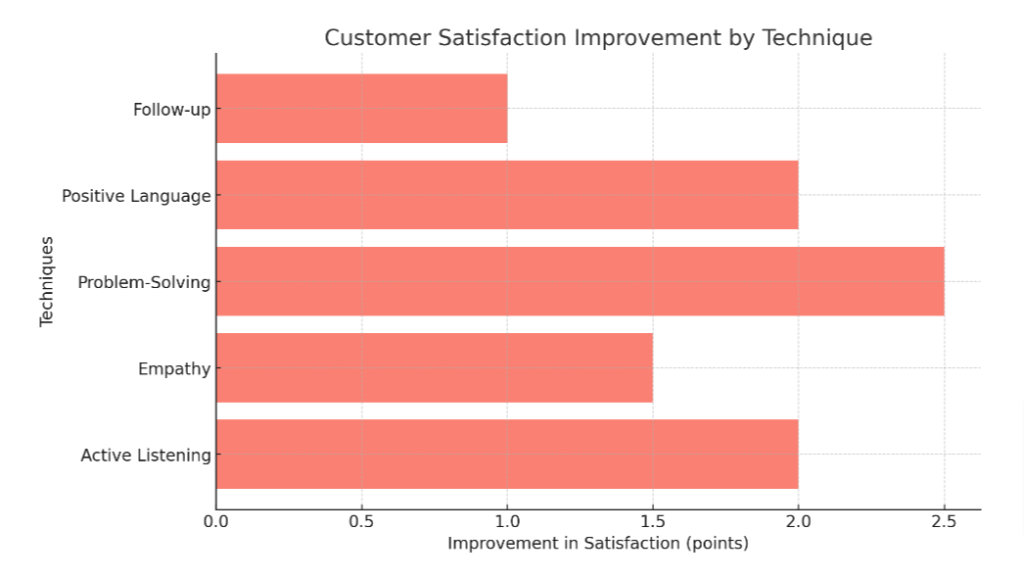From Conflict to Resolution: Strategies for Positive Outcomes in Live Chat
Sometimes, people can be tough to handle. It’s a fact that we all face negative interactions, whether at home, work, or in public spaces. This article will guide you through turning those tough moments into opportunities for positive outcomes.
Keep reading – it’s easier than you think!
Key Takeaways
- Practice quieting the negative inner voice with positive affirmations and mindfulness to shift your thinking from pessimistic to optimistic.
- Break free from the habit of complaining by recognizing patterns, challenging negativity, focusing on solutions, and surrounding yourself with positive influences.
- Develop active listening skills like maintaining eye contact, not interrupting, summarizing points, and showing empathy to build stronger connections during interactions.
- After a negative interaction, offer tailored empathy and proactive solutions. Follow up these actions with personalized communication to ensure satisfaction and demonstrate commitment.
- Use tools like the Feedback Matrix for self – evaluation after tough interactions; this helps identify areas for improvement and fosters personal growth.
Understanding Negative Interactions and How They Affect Us
Negative interactions, whether they come from a workplace spat, a miscommunication with friends, or poor customer service experiences can leave us feeling drained and discontent. They trigger our stress responses and can lead to a series of physiological reactions like increased heart rate and heightened emotions.
These responses may not only spoil our mood but also cloud our thinking, making it harder for us to respond effectively in the moment.
Managing these emotional reactions is crucial because they can impact our mental health if left unchecked. Wallowing in negative thoughts after an unpleasant exchange often leads to more negativity, creating a cycle that’s tough to break free from.
Conversely, turning negative energy into positive solutions fosters resilience and empowers us to handle future challenges better. It starts by acknowledging the effect these encounters have on us and deciding not merely to react but transform adversity into constructive action.
Strategies for Turning Negatives into Positives
Quiet the negative inner voice by practicing mindfulness and positive self-talk. Get off the complain train by focusing on finding solutions rather than dwelling on the problem. Always ask “What would I say to a friend?” as a way to gain perspective and offer support to yourself in times of negativity.
Convert negative energy into positive solutions by channeling it into problem-solving and action-taking.
Quiet the Negative Inner Voice
Negative thoughts can drain your energy and prevent you from transforming negative interactions into positive outcomes. It’s crucial to quiet the negative inner voice that holds you back.
- Recognize when negativity creeps into your thoughts. Awareness is the first step toward change.
- Challenge every pessimistic idea by asking yourself if there’s evidence to support it. Often, our fears are not based on facts.
- Replace each negative thought with a positive affirmation. This helps shift your mindset from negative to positive.
- Practice mindfulness to keep yourself anchored in the present moment, away from past regrets and future worries.
- Engage in positive self – talk as you would with a friend, using kind and supportive words for yourself.
- Set realistic goals for self – improvement to create a sense of progress and achievement, reinforcing a positive mindset.
- Use humor to lighten your mood when you notice negativity starting to affect you; laughter can be a powerful antidote.
- Surround yourself with people who encourage positivity; their energy can help transform your own thinking patterns.

Get Off the Complain Train
Constant complaining traps you in a cycle of negativity. Breaking free from this habit propels you toward more positive outcomes.
- Recognize complaint patterns: Pay attention to your frequent gripes and the triggers that start them.
- Challenge each complaint: For every negative thought, ask yourself if it’s truly necessary or productive.
- Redirect your energy: Focus on finding solutions instead of dwelling on problems.
- Set a ‘no complain’ goal: Aim for an hour, then a day, and gradually increase the time you spend without complaining.
- Surround yourself with positivity: Engage with people who have a constructive approach to challenges.
- Celebrate small victories: Acknowledge moments when you successfully avoid complaining.
Always Ask “What Would I Say to a Friend?”
When faced with negativity, it’s crucial to consider how you would advise a friend in the same situation. This simple question encourages a shift in perspective and helps in approaching negative interactions with empathy and understanding.
By adopting this mindset, it becomes easier to provide support, solutions, and kindness both to ourselves and others.
Positively changing your dialogue from self-criticism to encouragement can also enhance resilience against negative encounters. This transformative approach fosters an environment of empathy and mutual understanding.
Convert Negative Energy into Positive Solutions
Turn negative energy into positive solutions by actively seeking out the root cause of the negativity and brainstorming potential ways to address it. Make a conscious effort to identify opportunities within any negative situation and approach them with a problem-solving mindset
Look for constructive ways to channel negative energy into positive actions, such as taking steps to improve the situation or finding alternative perspectives. Embrace a proactive approach by creating actionable plans that can lead to favorable outcomes and initiate positive changes.
Cultivate an environment that encourages collaboration and creativity in transforming negativity into positivity within yourself and others.
How to Turn Negative Customer Interactions into Positive Experiences
Listen actively, offer empathy and solutions, and follow up with a positive action to ensure that negative customer interactions are turned into positive experiences.
Listen Actively
When engaging in conversations, focus on the speaker and maintain eye contact. Make sure to give the speaker your undivided attention to understand their perspective.
- Show genuine interest in what the speaker is saying by nodding and providing verbal cues such as “I see” or “Go on.”
- Avoid interrupting or formulating a response while the speaker is still talking. Instead, patiently wait for them to finish before contributing to the conversation.
- Reflect back on what the speaker has expressed by summarizing their points and asking clarifying questions if needed.
- Demonstrate empathy and understanding by acknowledging the speaker’s emotions and validating their experiences.
- Practice active listening techniques such as paraphrasing and mirroring to convey that you are truly engaged in the conversation.
Offer Empathy and Solutions
After actively listening to the customer’s concerns, it is vital to offer empathy and provide solutions that address their needs. Here are ways to effectively offer empathy and solutions in negative customer interactions:
- Acknowledge their feelings and concerns without judgment: Show genuine understanding of their emotions by acknowledging the impact of the situation on them.
- Put yourself in their shoes: Empathize with the customer’s perspective and demonstrate an understanding of their experience.
- Offer personalized solutions: Tailor your response to the specific needs and preferences of the customer based on their feedback and concerns.
- Provide proactive suggestions: Instead of just reacting to problems, take a proactive approach by offering alternative solutions or additional support.
- Communicate clearly and transparently: Ensure that the customer is fully informed about the steps being taken to address their concerns, maintaining open communication throughout the process.
- Follow through on commitments: Keep your promises and follow up with the customer to ensure that they are satisfied with the resolution offered.
- Express genuine concern: Convey sincerity in wanting to resolve any issues they have encountered, demonstrating a commitment to improving their experience.
Follow Up with a Positive Action
After offering empathy and solutions, it is essential to follow up with a positive action. This demonstrates your commitment to resolving the issue and leaves a lasting impression of exceptional customer service. Here’s how you can effectively follow up with a positive action:
- Implement the Solution Promptly: Once a solution has been agreed upon, take immediate steps to put it into action. Timely implementation shows that you value the customer’s time and concerns.
- Personalized Communication: Reach out to the customer personally to ensure that the solution has met their needs. This could be through a phone call, personalized email, or even a handwritten note.
- Ask for Feedback: Request feedback on their experience with the implemented solution. This shows that you are dedicated to continuous improvement and value their input.
- Offer Incentives or Discounts: As a gesture of goodwill, consider offering incentives or discounts on future purchases as a thank-you for their patience and understanding.
- Express Gratitude: Always express gratitude for their business and express genuine appreciation for the opportunity to resolve their concerns.
- Document the Interaction: Make sure to document the entire interaction and resolution process in detail within your customer database for future reference.
Building Resilience: How Negative Interactions Can Help Us Grow and Learn

Discover how negative interactions can actually be used as opportunities for personal growth and learning, including tactics such as getting to know your inner chimp and utilizing positive affirmations to shift mindset.
Create a culture of turning negatives into positives for long-term resilience.
Getting to Know Your Inner Chimp
Understanding the inner chimp within us is crucial for managing negative interactions effectively. Recognizing our primal instincts and emotional responses helps in gaining control over our reactions to challenging situations.
By acknowledging the inner chimp, we can consciously choose positive affirmations and mindset shifts to steer ourselves towards constructive outcomes despite adversity. This awareness empowers us to handle negative emotions with resilience and transform hostile encounters into favorable results.
Acknowledging the existence of our inner chimp allows us to develop strategies for transforming adverse interactions into positive consequences. Embracing this understanding creates space for a mindset shift from negative to positive, fostering workplace positivity and emotional resilience.
Use Positive Affirmations
Boost your confidence and motivation by incorporating positive affirmations into your daily routine. Embrace the power of positive self-talk and mindset reinforcement to overcome negativity and build emotional resilience.
- Start each day with uplifting affirmations that focus on your strengths and capabilities, such as “I am capable of overcoming challenges” or “I have the power to create positive change.”
- Use affirmations to reframe negative thoughts into constructive beliefs, replacing self-doubt with statements like “I trust in my problem-solving abilities” or “I am resilient in the face of adversity.”
- Repeat affirmations throughout the day to maintain a positive mindset and counteract moments of doubt or stress, reinforcing phrases like “I am adaptable and can handle any situation” or “I choose to focus on solutions rather than problems.”
- Create a list of personalized affirmations that resonate with you, addressing specific areas where you want to shift from negative thinking to constructive perspectives.
- Incorporate visual cues, such as sticky notes or digital reminders, to keep your affirmations visible and easily accessible, allowing them to serve as constant reminders of your inner strength and potential for growth.
- Practice self – compassion through affirmations that promote kindness towards yourself, acknowledging your worthiness and value with statements like “I deserve success and happiness” or “I am worthy of love and respect.”
- Utilize affirmations as tools for cultivating gratitude, focusing on appreciation for what you have rather than dwelling on what is lacking in your life.
- Embrace the transformative impact of positive affirmations by integrating them into your thought patterns, language, and overall approach to navigating challenging situations.
- Share the practice of positive affirmations with others, fostering a supportive environment where individuals can uplift one another through empowering words and encouragement.
Utilize the Feedback Matrix Tool
To utilize the Feedback Matrix Tool:
- Evaluate the specific negative interaction or situation, pinpointing the exact issue and the emotions it evoked.
- Break down the interaction into its various components, such as what was said, body language, and other contextual factors.
- Identify both the negative and positive aspects of the interaction to gain a balanced perspective on the situation.
- Analyze how you contributed to the negative outcome and what could have been done differently.
- Consider external factors that may have influenced the interaction and contributed to its negativity.
- Brainstorm constructive solutions or actions that could be taken to address any similar negative interactions in the future.
- Reflect on what was learned from the experience and opportunities for personal growth and development.
Create a Culture of Turning Negatives into Positives
Encourage open communication to address challenges and find solutions proactively.
- Foster a supportive environment that embraces constructive feedback and encourages learning from setbacks.
- Lead by example, demonstrating resilience and a positive mindset in the face of adversity.
- Provide opportunities for team members to share success stories of turning negatives into positives, fostering a culture of optimism and problem-solving.
Conclusion
In conclusion, transforming negative interactions into positive outcomes requires a shift in mindset and proactive strategies. By actively listening and offering empathy, we can turn negative customer interactions into positive experiences.
Building resilience through positive affirmations and converting negative energy into solutions allows us to grow and learn from adverse encounters. Creating a culture of turning negatives into positives is key to fostering workplace positivity and problem-solving.

